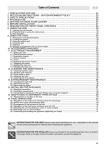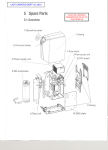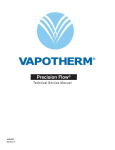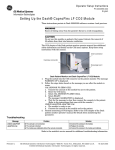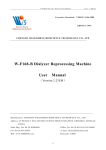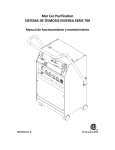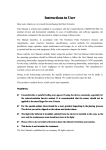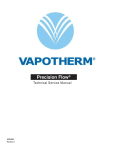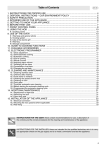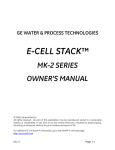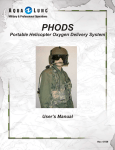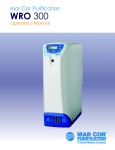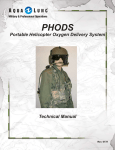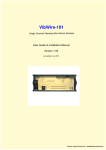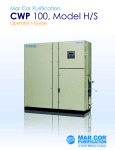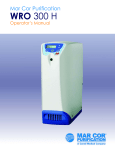Download Vapotherm 2000i
Transcript
2000i Operating Instruction Manual Contents Page Section 1 Indications and Contraindications 3 Section 2 Definitions, Warnings and Cautions 3 Section 3 About Vapotherm 2000i Product Description 5 Section 4 4.1 4.2 4.3 4:4 4:5 4:6 General 2000i Set up and instructions Set Up – The 2000i Unit Set Up – Selecting the Vapor Transfer Cartridge Set Up – Inserting the Vapor Transfer Cartridge Set Up – Inserting the Patient Delivery Tube Set Up – Vapotherm Spike Set (VSS-1) Set Up – Connect to a Gas Source 7 7 8 8 9 9 Section 5 5:1 5:2 5:3 5:4 5:5 5:6 5.7 Operations Operations – Prepare for Activating the Unit Operations – Turn on Flow Operations – Priming the Unit Operations – Activate the Unit Operations – Setting the Temperature and Warm-Up Operations – Connecting to a Patient Operations – General Guidelines Section 6 6.1 6.2 6.3 6.3.1 6.3.2 6.3.3 Alarms and Troubleshooting General Alarm and Troubleshooting Table Component Change-outs Replacing the Vapor Transfer Cartridge Replacing the Patient Delivery Tube Replacing the VSS-1 Spike Set Section 7 Removing From Patient and System Shut Down Section 8 8.1 8.2 8.3 8.4 8.5 8.6 Routine Disinfection Procedure Disinfection Supplies Pre-cleaning Process Pre-disinfection Cleaning and Decontamination Set-up Disinfect Gas and Water Circuits Drying Section 9 9.2 Specifications Definitions and symbols 22 22 Section 10 Warranty Information 23 Section 11 Reference and Bibliography 24 ™ Appendix A – Disinfection Solution Appendix B – Sample Disinfection Log Operating Instruction Manual Section 1 Indications and Contraindications Primary Indications: Used to warm and humidify breathing gases, generally prescribed during oxygen therapy where concentrations of oxygen greater than ambient air are utilized to treat symptoms and manifestations of hypoxia including: • Documented hypoxemia: decreased Pa0 in blood below normal range 2 10 10 10 10 11 11 12 • Acute care in which hypoxemia is suspected • Severe trauma • Acute myocardial infarction Secondary Indications: • Managing hypothermia • Treating bronchospasm caused by cold air Contraindications: General: • Any situations in which humidification is contra-indicated (see AARC Clinical Practice Guidelines) Specific to Nasal Cannula: • Patients with occluded or defective nares should not use the system. Section 2 Definitions, Warnings and Cautions 2.1 Definitions 13 13–14 15 15 15 15 16 17 17 18 18–19 20 21 25–26 27 Page 2 A WARNING indicates that a potentially harmful situation may occur. A CAUTION indicates a condition that may lead to equipment damage, malfunction, or inaccurate operation. A NOTE indicates a point of emphasis to make operation more efficient or convenient. Aseptic Technique is practices and procedures performed under carefully controlled conditions with the goal of minimizing contamination by pathogens. Specifically with respiratory equipment, especially with reference to the Vapotherm 2000i, this includes proper hand washing and avoiding direct hand contact with connection points. Please take the time to familiarize yourself with the definitions, warnings, cautions and notes listed in this manual. They cover safety considerations, special requirements, and regulations. The user of this product assumes sole responsibility for any malfunction due to operation or maintenance performed by anyone not trained by Vapotherm™ staff or official training documentation. When handling any part of the Vapotherm 2000i, always follow hospital infection control guidelines and Standard Precautions. Vapotherm recommends that users follow the disinfection procedure found in this manual. Vapotherm also recommends that users follow the Centers for Disease Control (CDC) publications: Guidelines for Maintenance of In-Use Respiratory Therapy Equipment and Guidelines for Prevention of Nosocomial Pneumonia. ® 2.2 General Warnings • Federal Law (U.S.) restricts the sale of this device to, or by the order of any physician. • This is a humidification device generally used for providing continuous flows of breathing gas. The Vapotherm 2000i is not a ventilatory device and should not be used as life support. ® • This device will not operate without flow. Operating Instruction Manual Page 3 Section 2 Warnings and Cautions Section 2 Warnings and Cautions General Warnings (cont.) 2.4 General Inspection • The Vapotherm 2000i must be disinfected between each patient use and after 30 days of use on the same patient. • Gas flow delivered by this device is limited to 40 liters per minute. Maximum operational flow rate should not be exceeded. • Prior to use machine should be positioned and secured to a sturdy IV pole. • The system includes several disposable elements that are labeled as single patient use only: do not attempt to sterilize or reuse. Follow all local and federal regulations for disposal. • Oxygen supports combustion; this device should not be used near or around open flames, oil, grease or any flammables or anesthetics. • Performance verification must be performed prior to use. • Service on the device should be performed by qualified, certified service technicians ONLY. • To prevent injury do not attempt to perform any service to the Vapotherm 2000i while a patient is connected to the device. • If the device is damaged or not working properly do not use. Contact Vapotherm or your authorized Vapotherm representative. • Do not operate if power cord is damaged. • The device should not be turned on and left unattended. • Do not use the Vapotherm 2000i in or around water other than the water bag that feeds the system. • Failure to utilize sterile water supply or clean gas supply may increase risk of bacterial contamination. • The Vapotherm 2000i utilizes warmed water and can pose a risk for colonization of bacteria and patient infection if disinfection procedures are not followed. • Gas flow is external to the Vapotherm, but the care giver should confirm the integrity of all respiratory gases utilized to ensure they are free of contamination. • Gas supply must be made of clean dry medical grade gas to prevent harm to the patient and prevent damage to the Vapotherm 2000i. • An oxygen analyzer with alarms must be used when the delivered concentration level is critical. The Vapotherm 2000i does not provide oxygen concentration analysis capability. • To reduce any potential transmission of contaminated water from the system, all assembly and/or disassembly of the unit should take place outside the primary care areas. When unpacking the Vapotherm 2000i system , ensure that the unit is inspected for damage before use. Report any damage or missing parts immediately to your authorized Vapotherm distributor. ® When renting a Vapotherm 2000i, customers should require the rental service to provide a certification that the machine has been disinfected before accepting delivery. Section 3 About the Vapotherm 2000i and 2000h The Vapotherm™ 2000h for home use consists of the combination of a 2000i unit and the “Home Care Compressor Kit (Part number HCK200-M)”. The HCK-200 Kit consists of an HS-100 Stand, a 5060A Room Air Compressor and Flowmeter assembly. 1. A Vapotherm authorized Durable Medical Equipment (DME) Supplier is responsible for the following: • • • • • Assembling the 2000i unit and the kit components Instructing the user in their responsibilities for operating the system Providing 1000 ml sterile water bags as needed Routine servicing of the system R emoving, replacing, and disposing of the disposable components (Vapor Transfer Cartridge, Vapotherm Spike Set -1 & Delivery Tube) every 30 days • D isinfecting of the 2000i unit every thirty days following the procedure found in Section 8.1 – 8.6 of the 2000i Operating Instruction Manual 2. The user/home care provider is responsible for the following: • • • • Change nasal cannulas when soiled or excessively wet from secretions. Dispose of properly. Installing and replacing the sterile water bag Avoid liquid spills on the components Do not attempt any repairs. If you have any problems with your Vapotherm 2000i device notify the DME provider immediately • The 2000i is not a Continuous Positive Airway Device (CPAP). There are no controls to deliver or monitor airway pressure. The 2000i humidifies breathing gases that are delivered externally through standard air/oxygen blender and flowmeter. The 2000i should not be used to deliver pressure in a closed system. 2.3 Cautions • Verify that the power source is compatible with the electrical specifications shown on each component. For proper grounding reliability, connect the 2000i power cord only to a properly marked hospital grade receptacle. DO NOT USE EXTENSION CORDS. If any doubt exists as to the grounding connection, DO NOT operate the device. • Do not immerse the Vapotherm 2000i in water. Do not steam or gas sterilize the Vapotherm 2000i. • Read and understand this manual prior to operating the system. • The Vapotherm 2000i must be disinfected if the water circuit is opened up by removing or replacing a component. • Aseptic techniques (including proper hand washing and avoiding direct hand contact with connection points) and Standard Precautions should always be followed when handling medical equipment. • Standard Precautions should always be followed when coming in contact with patients. Operating Instruction Manual Page 4 Operating Instruction Manual Page 5 Section 4 Set-up Section 3 About the Vapotherm 2000i ® The Vapotherm 2000i warms and humidifies flows of air, oxygen or medical gas blends for delivery to a patient, by nasal cannula or Vapotherm approved interface.Warming and humidification of breathing gas occurs in a Vapor Transfer Cartridge, where air and water are separated by a membrane permeable to water vapor. The membrane consists of microtubules constructed of polysulfone material. The membrane meets HIMA (Health Industry Manufacturers Association) standards on filters for sterilizing liquids and has been shown to effectively exclude bacteria from crossing from the water circulation to the gas flow. The warmed humidified gas stream reaches the patient via a patented triple lumen Patient Delivery Tube. Humidified gas flow is delivered through the center lumen. The outer lumens contain water which is warmed via an internal heater and propelled through the system via an internal pump (See schematic, fig. 1). This maintains breathing gas temperature and minimizes condensation. The final patient interface is a Vapotherm nasal cannula or approved interface configured to minimize resistance and heat loss. NOTE: The water circuit and gas circuit of the Vapotherm 2000i do not come in contact with each other. Respiratory gases are supplied to the Vapotherm™ 2000i from an external gas supply, typically through a standard wall-mounted flow meter connected to the hospital medical gas supply. Gas flow rate is controlled by the external flow meter or medical gas blender. There are no flow controls on the Vapotherm™ 2000i. Connections for gas flow and water are made via the rear panel. All Vapotherm 2000i controls are on the front panel of the device. WARNING: Use of patient interfaces not recommended by Vapotherm may cause safety concerns or affect the performance of the device. 1. The back of the 2000i has an IV pole clamp that enables IV pole attachment. 2. The unit should be mounted on a sturdy IV pole approximately two feet from the top of the pole to facilitate ease of access and proper flow from sterile water system. Mounting pole 4. Connect blender hoses into both air and oxygen wall connections. 5. Plug Vapotherm power cord into a hospital wall power outlet. Air/Oxygen Blender WARNINGS: Flowmeter Aseptic technique (including proper hand washing and avoiding direct hand contact with connection points) should always be followed when setting up and operating the Vapotherm 2000i. VSS-1 Spike set Air line Oxygen line Closed system components (VSS-1, Vapor Transfer Cartridge and Patient Delivery Tube) should not be opened in patient care area. Vapor Transfer Cartridge Simple, easy to use touch control panel and information screen. 4.2 Selecting the Vapor Transfer Cartridge Vapotherm provides both a high flow cartridge (VT01-AS) and a low flow cartridge (VT01-BS). • Pump Heater • Heated Delivery tube Vapotherm Vapor transfer cartridge 2000i The high flow cartridge (VT01-AS) should be used with the pediatric cannula with an operational flow range of 5 – 20 liters per minute (lpm) or with adult sized cannula with an operational flow range of 8– 40 lpm. The low flow cartridge (VT01-BS) should be used with the neonatal, premature, infant, or intermediate sized cannula with an operational flow range of 1– 8 lpm. Delivery tube Note: System specification and front panel layout may vary. WarningS: Do not exceed maximum operational flow rates of 40 lpm for the high flow cartridge (VT01-AS) and 8 lpm for the low flow cartridge (VT01-BS). Breathing Gas to Patient Fig. 1Simplified System Diagram Operating Instruction Manual Sterile Water Bag 3. If using an oxygen blender, mount the blender above the Vapotherm 2000i on the IV pole. The medical gas source is external to the Vapotherm 2000i. Always verify the integrity of the medical gas source and utilize bacterial filters if necessary. Breathing Gas Inlet Water Reservoir 4.1 The 2000i Unit Ensure that the correct cartridge is inserted before operating. Page 6 Operating Instruction Manual Page 7 Section 4 Set-up 4.3 Inserting the Vapor Transfer Cartridge Section 4 Set-up 4.5 Vapotherm Spike Set (VSS-1): for connecting Sterile Water Bag Fig. 1 1. The Vapor Transfer Cartridge (VT01-AS or VT01-BS) attaches to the unit by two water and two air connections. 1. Hang a sterile water bag from IV Pole. 2. When facing the unit, access is via a hinged cover on right side. The cartridge may be fitted in either direction. 2. Connect VSS-1 to the water inlet port on back of unit and make sure it locks into place (Fig. 5). 3. Date the cartridge. 3. Ensure the VSS-1 is clamped then remove spike cap. Wipe spike with disinfectant wipes, 70-90% isopropyl alcohol. 4. Remove protective caps from luer side ports of cartridge (Fig. 1). 5. Attach lower air tube from Vapotherm 2000i to lower end of cartridge. 4 6. Insert projecting side ports into matching connections in unit. Press cartridge firmly into place (Fig. 2). 5. Leave VSS-1 spike set clamped until ready to fill unit. 7. Attach upper air tube from Vapotherm 2000i to top of cartridge (Fig. 3). Make sure tubing is not kinked. Firmly insert spike into sterile water bag while avoiding direct hand contact with the spike tip and water bag septum. WARNINGS: The VSS-1 is single patient use item and should be changed with each patient. Fig. 2 8 . Close hinged cover. If it does not close easily, check that cartridge is pressed fully into place and that air tubes are not interfering with cover. If the VSS-1 is removed from the Vapotherm device for any reason the Vapotherm 2000i should be disinfected following the routine disinfection procedure before being returned to service. WARNINGS: The cartridge must be changed between patients and discarded after each use. CAUTION: Never leave the VSS-1 unclamped when the system is not running. Fig. 5 NOTE: Removing an empty sterile water container does not constitute opening the closed system. New sterile water containers can be spiked using the same VSS-1 without removing the device from service following the procedure above. If the cartridge is removed, the unit should be disinfected. If the cartridge is dropped, it should be discarded. NOTE: Do not remove cartridge from the Vapotherm 2000i without first draining the machine. 4.4 Inserting the Patient Delivery Tube Fig. 4 4.6 Connect To A Gas Source Fig. 3 1. Connect a source of air, oxygen or medical gas blender to the gas inlet port of Vapotherm 2000i (Fig. 6). Gas inlet connection is a hose barb that accepts female fitting on a standard 1/4” (6.35mm) oxygen tube. 1. Insert Patient Delivery Tube into lower portion of the unit by aligning blue tabs on tube with notches on bottom of unit. 2. Firmly press into place (Fig. 4, see next page). Blue lip on tube must be flush with the bottom of unit. Fig. 6 NOTE: Vapotherm will not operate unless there is gas pressure at gas inlet. With no flow/pressure sensed, a “System Failure” alarm will sound. 3. Rotate 1/4 turn clockwise and pull slightly downwards to lock into place (Fig. 4, see next page). WARNING: The Patient Delivery Tube is a single patient use item and should be changed with each patient. If the Patient Delivery Tube is removed from the device for any reason the Vapotherm 2000i should be disinfected following the routine disinfection procedure before returning to service. CAUTION: Unit will not operate correctly if the Patient Delivery Tube is inserted improperly or not locked into place. Operating Instruction Manual Page 8 Operating Instruction Manual Page 9 Section 5 Operation of The Vapotherm 2000i Section 5 Operation of The Vapotherm 2000i ™ ™ 5.1 Prepare for Activating the Unit 5.5 Setting the Temperature and Warm-Up Fig. 1 1. Ensure that the Vapotherm 2000i power cord is plugged into a hospital electrical wall outlet. 1. The Vapotherm 2000i displays the actual temperature of the circulating water. Press and release the up or down arrow on the front of the unit to display temperature setting for 3 seconds. 2. Unclamp the Vapotherm Spike Set (VSS-1) (Fig. 1). 2. To adjust the temperature setting of the Vapotherm 2000i, press and hold the up or down arrow until the desired temperature is displayed in the LED. 5.2 Turn on Flow NOTES: The Vapotherm 2000i always defaults to previous set temperature at power up. 1. If using the high flow cartridge (VT01-AS) flow should be started at least 8 lpm for warm-up. The temperature can be set between 33 and 43˚C. 5.6 Connecting to Patient 2. If using the low flow cartridge (VT01-BS) flow should be set to at least 5 lpm for warm-up. 3. Turn on flow. S 5.3 Priming the Unit 1. Wait for desired operating temperature to be reached BEFORE placing the cannula on the end of the Patient Delivery Tube. 2. Check water level, temperature display and gas flow rate. Fig. 2 3. Size cannula to patient by ensuring that nasal prongs do not fit tightly into nares. 1. Unit should be started in CLEANING MODE “CL” to prime a new Patient Delivery Tube. 2 4. Attach properly sized cannula that is designed to function with the cartridge installed in the machine onto the delivery tube. Adjust the flow to the desired rate and place the cannula on the patient. C To place unit in CLEANING MODE, press both the power on and the ALARM SILENCE/MUTE buttons simultaneously (Fig. 2). 5. Some condensation of moisture around nose is possible. In addition, high moisture level may mobilize mucus from nose and sinuses. Make sure patient has a supply of tissues. S 3. The display will show “CL” and LED next to cleaning icon will illuminate. 4. Water will begin to circulate and fill the Patient Delivery Tube. Mute Cartridge Cannula Type Operational Flow Rates Power High Flow (VT01-AS) Adult 8 – 40 lpm High Flow (VT01-AS) Pediatric 5 – 20 lpm Low Flow (VT01-BS) Premature, neonatal, infant, intermediate 1 – 8 lpm 5. Operate in CLEANING MODE until Patient Delivery Tube has been purged of air bubbles. 6. When air has been purged, press POWER to stop system 7. Wait until display blanks. WARNINGS: Always follow aseptic technique (including proper hand washing and avoiding direct hand contact with connection points) when setting up the Vapotherm 2000i and Standard Precautions when placing on a patient. Fig. 3 NOTES: Pressing both the power and alarm mute buttons will set unit in CLEANING MODE, pressing only the power button sets unit in NORMAL mode. Cannula should not obstruct the nares of the patient. Change nasal cannulas when soiled. Water is not being heated in CLEANING MODE: the purpose of this mode is to fill the outer lumens of the Patient Delivery Tube with water. After start-up, during the normal purging of the Patient Delivery Tube, air will release and appear as bubbles in the bubble trap of the VSS-1. If the Patient Delivery Tube is filled and a stream of continuous bubbles appear in the bubble trap, it may indicate a problem with the cartridge or Patient Delivery Tube and both should be checked or changed. Gas flow is highly recommended (but not mandatory) during priming. NOTE: If using a low flow cartridge (VT01-BS) the flow cannot be decreased below 5 lpm until an appropriate cannula has been attached to the delivery tube 5.4 Activate the Unit 1. Press the Power button only, to start in NORMAL MODE (Fig. 3). Droplets of condensation may appear at the end of Patient Delivery Tube while unit is warming up. This is normal and will stop within a few minutes when temperature is reached. If this condition continues refer to trouble shooting section. If the system operates while not connected to a patient, condensation is likely to develop. 2. If not using the Patient Delivery Tube with integrated cannula, do not place cannula on the end of tube until warm up is complete. Operating Instruction Manual Page 10 Operating Instruction Manual Page 11 Section 5 Operation of The Vapotherm 2000i Section 6 Alarms, Trouble Shooting and Component Change-Outs ™ 5.7 Operations – General Guidelines 6.1 General 1. Check that water is properly circulating through the machine by making sure the Patient Delivery Tube is warm across the entire length. 1. Periodically check for alarm conditions. 2. If good circulation cannot be confirmed, check that the water flow is not obstructed by air bubbles. 2. Unit will shut down if there is no gas flow. However, flow will not be interrupted if unit shuts down or malfunctions for any other reason. 3. Take precautions to minimize cooling of the unheated cannula by trying to maintain contact with the patient’s skin and insulating the exposed portion of the cannula with bedding. 3 4. Cartridge door should be closed during operation. NOTE: Condensation in the cannula may occur at low flow rates. To minimize condensation, these general guidelines should be followed: • If using flow rates less than 5 lpm, do not set the temperature higher than 34ºC. • The Vapotherm unit should not be in a position where it is cooled (eg. by an air conditioning outlet). Unit will shut down if temperature safety limits are exceeded, or if water level is low for more than 4 mins. However, unheated gas flow will continue. NOTE: Should a malfunction occur, indicators on the front panel will light and an alarm will sound. If the actions listed here do not correct the problem causing the alarm, the unit should be returned to an approved facility for service. 6.2 Alarms and Troubleshooting Caution: DO NOT EXCEED flows of 8 lpm for VT01-BS and 40 lpm for VT01-AS cartridge. DO NOT SET flows below 1 lpm for VT01-BS. Alarm indication Cause Action WARNING: Never occlude the nares with cannula. Water low Water is not filling system properly Make sure VSS-1 spike set is open, and the tube is not kinked or blocked by air bubbles. Low Water Pressure Make sure gas and water connections are open, gas can flow to unit, and air has purged from water system: if not, run ‘CLEANING MODE’. NOTES: It may become necessary to disconnect the cannula from the Patient Delivery Tube for short periods, such as when moving a patient out of a radiant warmer. At flow rates less than 5 lpm, cannula disconnection will activate a system failure alarm, requiring a reset. To avoid this alarm, briefly turn off unit by pressing the power key once. The display will show two bars. Disconnect the cannula from Patient Delivery Tube and move the patient, reconnect the cannula, then press the power key once more to restart the unit. A SYSTEM FAIL (88) alarm will activate if there is insufficient gas pressure in the manifold. If no cannula is fitted, flow rate at startup should be at least 5 lpm. The minimum flow rate for operation is 1 lpm if a neonate, infant or premature-sized cannula is fitted, 5 lpm with a pediatric cannula, and 8 lpm with an adult cannula. S System Failure Malfunctioning Water or Gas Pressure Sensor Insufficient gas or water pressure. Cannulas are single use patient items, dispose of as necessary or according to your institution’s guidelines or when visibily soiled or excessively wet from secretions. Weekly change out is recommended to avoid any hardening of nasal prongs. Send in for service. Make sure the gas and water circuits are open and functional and air has purged from the water circuit if the unit is in normal operating mode. Run in “CLEANING MODE”. An air lock can develop at the pump, preventing normal water flow. Try restarting the unit in cleaning mode. Malfunctioning Water or Gas Pressure Sensor S Make sure there is correct flow for cartridge flow rates. If using <5lpm with a low flow cartridge, a nasal cannula must be attached. If a component failure return the unit for service. NOTE: To restart after a system failure, the unit must be reset by a momentary pressure on the Power button. Do not hold the Power button. The alarm will shut off after a delay of about a second, and the unit can then be restarted normally. Cartridge Operating Instruction Manual Page 12 Water drops in the circuit will cause a cartridge alarm; this does not necessarily mean the cartridge needs to be replaced. Operating Instruction Manual Page 13 Section 6 Alarms, Trouble Shooting and Component Change-Outs S 6.3 Component Change Outs Alarm indication Cause Cartridge If the Cartridge Alarm is continuous and air bubbles are rising into the VSS-1 bubble trap or if a flow or water is visible in the tube below the cartridge, then the cartridge has failed. First disconnect the patient from the unit, shut down unit, drain unit, disinfect unit, replace cartridge, VSS-1 and delivery tube, and follow set up instructions. If cartridge alarm is intermittent and there are no bubbles in the VSS-1 bubble trap or no obvious water flow below the cartridge there may be condensation in the system. Occasional brief alarms due to condensation are not a cause for concern. Try briefly pinching and releasing tube under cartridge to dislodge the drops and/ or decrease set temperature. High Temperature Alarm Malfunction of Temperature Control System. Shut down system and return for service. Blocked Tube Alarm High water or air pressure due to high resistance in water circulation or air outlet: or malfunctioning pressure sensor. S S Section 6 Alarms, Trouble Shooting and Component Change-Outs Action NOTE: A momentary High Temperature alarm may occur when the unit has been switched off and on again. If the temperature then stabilizes, no action is needed. Fig. 1 WARNINGS: The vapor transfer cartridge, patient delivery tube, and VSS-1 spike set are all single use only and should be discarded after removal from the Vapotherm 2000i. The Patient Delivery Tube, VSS-1 and Vapor Transfer Cartridge should not be changed or replaced in the patient care area. The system must be disinfected any time the Vapor Transfer Cartridge, VSS-1 or Patient Delivery Tube are removed. NOTE: The cannula and sterile water source can be replaced without disinfecting the system. As with all respiratory equipment, proper hand washing techniques should be followed before contacting or replacing any patient interfaces. 6.3.1 Replacing Vapor Transfer Cartridge Fig. 2 1. 2. 3. 4. Power off unit. Disconnect gas flow. Close clip on VSS-1. (Fig. 1) Open hinged cover. Disconnect air tubes from cartridge ends by pressing tubing away from cartridge. 5. Remove cartridge by pulling straight outwards. (Fig. 2) 6. Proceed to Section 8.0 and disinfect the Vapotherm 2000i device before returning the device to service. 7. For set-up please refer to Section 4.3 of the manual. CAUTION: Do not grip cartridge tubing with sharp instruments. ® Blocked tube alarm due to high WATER pressure will cause a continuous or intermittent tone and alarm light. The flow of breathing gas continues, but is no longer heated. Check that delivery tube is correctly positioned, rotated clockwise, and pulled into locked position. Check that water is circulating within delivery tube. If alarm persists replace delivery tube and/or cartridge. Disinfect unit prior to replacing components. Blocked tube alarm due to high GAS pressure will cause a 5 second alarm tone. If the obstruction persists the system will continue to alarm in 5 sec episodes. Water circulation continues but the heater shuts off. Find and correct the cause of obstruction. The most common cause is a kink in the nasal cannual or in the prong. Attempting to run the Vapotherm 2000i at very high flow through a patient interface not approved by Vapotherm may also raise the internal pressure sufficiently to trigger a Blocked Tube Alarm. 6.3.2 Replacing the Patient Delivery Tube Fig. 3 1. Power unit off. Disconnect gas flow. 2. To remove tube, push base of tube upwards, rotate 1/4 turn counter clockwise and pull downward. (Fig. 3) 3. Proceed to Section 8.0 and disinfect the Vapotherm 2000i device before returning the device to service. 4. For set-up please refer to Section 4.4 of the manual. ® 6.3.3 Replacing the VSS-1 Spike Set 1. Power off unit. Disconnect gas flow. 2. Clamp VSS-1 and remove VSS-1 Spike Set from the water inlet port on the back of the Vapotherm 2000i by releasing the quick connect on the water inlet port. 3. Proceed to Section 8.0 and disinfect the Vapotherm 2000i device before returning the device to service. 4. For set-up please refer to Section 4.5 of the manual. ® If further assistance is needed please call your clinical product specialist or local distributor representative. Operating Instruction Manual Page 14 Operating Instruction Manual Page 15 Section 7 Removing From Patient and System Shut Down 1. Remove cannula or other interface from patient. 2. Press and release power switch (Fig. 1). Display will show “--” 3. Close clip on VSS-1 (Fig. 2). Section 8 Routine Disinfecting Protocol 8.1 Disinfection Supplies Fig. 1 1. DK-301 (a-e included in kit) a. Disinfection Bag A c. Disinfection Tube e. Y-Spike Assembly 2. Gloves 3. Safety Glasses 4. Disinfectant wipes, 70-90% isopropyl alcohol 5. Approved Disinfectant 6. 1000ml Sterile Water Bag 7. Medical Grade Air Source 8. Standard adult flow meter with oxygen 7ft tubing attached NOTE: The system’s pump continues to run for 1 minute to allow heater to cool down. 4. After 1 minute, water pump shuts off and numeric display is blank. Unit may now be disconnected from power outlet. 5. Remove unit from patient care area and proceed to disinfection process. CautionS: Avoid disconnecting from power or gas sources while machine is operating. Do not unplug from power source until display is blank. b. Disinfection Bag B d. Cartridge Bypass Tubes WARNINGS: Vapotherm should be disinfected after each patient or every 30 days on a single patient. Do not disinfect in an open patient care area. The DK-301 disinfection kit is a single use item. Operators should open a new disinfection kit for each disinfection procedure and discard the components at the end of the procedure. Disinfection Procedure should be performed in a well ventilated area. Use Standard Precautions and aseptic techniques during this procedure. The Vapor Transfer Cartridge should NOT be in place when disinfecting the unit. The Vapor Transfer Cartridge is a single use disposable and must be discarded after each patient use. DK-301 is not designed to disinfect Vapor Transfer Cartridges. Fig. 2 8.2 Pre-Cleaning Process 1. After patient use, it is recommended that the Vapotherm 2000i System remain attached to the iv pole with all the component parts intact. 2. Move the Vapotherm 2000i System to a hospital approved reprocessing area outside the patient care area. Fig. 1 Warning: The water circuit of the Vapotherm 2000i System is not sterile and can potentially have bacterial contamination. The water circuit of the device should never be opened in a patient care area. Transport the Vapotherm 2000i System to an appropriate area for draining, cleaning and disinfection. 3. Wash hands and put on gloves. 4. Drain the Vapotherm 2000i System in a receptacle by cutting the delivery tube. (Fig. 1) 5. Remove and dispose of the delivery tube, cannula, VSS-1 spike set, and sterile water source. 6. Remove and dispose of the vapor transfer cartridge. Warning: The water circuit of the Vapotherm 2000i system has the potential for bacterial growth so standard precautions should be used to open the water circuit. Disposable components should be disposed of in accordance with hospital guidelines and operators should wash their hands after breaking down the device. Operating Instruction Manual Page 16 Operating Instruction Manual Page 17 Section 8 Routine Disinfecting Protocol Section 8 Routine Disinfecting Protocol 8.3 Pre-Disinfection Cleaning and Decontamination 1. Wash hands and put on new gloves. 8.4 Set-up (cont.) Fig. 2 6. Hang Bag A with 200 ml of approved disinfecting solution from IV pole hook. Warning: Always use standard precautions when cleaning and disinfecting the Vapotherm 2000i system. Always use individually wrapped 70-90% isopropyl alcohol disinfectant wipes when wiping down the Vapotherm 2000i and disinfection kit components. Always use a new disinfectant wipe taken directly from the package or container and ensure that the disinfectant wipe has not dried out before using it on the Vapotherm 2000i device. 7. Wipe blue end of disinfection tube with an approved disinfectant wipe. Insert into bottom port of Vapotherm 2000i system. Press firmly into place, rotate 1/4 turn clockwise, and pull down slightly to lock in position. (Fig. 5) ™ 8. Wipe the other end of the disinfection tube with an approved disinfection wipe and attach it to the bottom outlet of Bag A. Lock into place. (Fig. 6) 2. Wipe exterior casing including inside hinged cover with an approved disinfectant wipe. (Fig. 2) 3. Wipe inside and outside of the following connections with an approved disinfectant wipe: a. Four cartridge connection ports inside hinged cover (Upper and lower cartridge air tubes and the water connection ports) b. Water inlet and air inlet connectors on rear of unit c. Delivery tube port on the bottom of unit. 9. Suspend Bag B on a separate hook on IV pole. Cap should be firmly closed to minimize potential spilling. 10. Attach Y-Spike Assembly by: Fig. 3 Fig. 6 a. Disinfect wipe male colder fitting end of Y- Spike Assembly and insert it into water inlet port on the back of the Vapotherm 2000i system. Lock into place. (Fig. 7) b. Disinfect wipe the O bushing connector end of the Y-Spike Assembly. Attach connector to the air inlet connector port on the back of the Vapotherm 2000i system. (Fig. 8) 2 8.4 Set-up c. Disinfect wipe the spike end of the Y-Spike Assembly and insert into bottom outlet of Bag B until it comes to a stop. 1. Take the 4 inch bypass tube with 90° barb fittings (Bypass Tube A) and wipe the ends with an approved disinfectant wipe. Press firmly into the inner cartridge connection ports (water circuit). (Fig. 3) Warning: If spike is not properly inserted, it may cause disinfectant to leak creating a potential safety risk. The spike should be inserted into Bag B up to the ridge at the bottom of the spike. Do not insert the spike past the ridge at the Fig. 7 bottom of the spike. 2. Take the 6 inch bypass tube with straight barb fittings (Bypass Tube B) and wipe the ends with an approved disinfectant wipe. Insert firmly into outer upper and lower cartridge ports (air circuit). (Fig. 4) Warning: The By-pass Tubing has been designed to optimize the flow of solutions through the Vapotherm 2000i system. Failure to use the By-Pass Tubing supplied by Vapotherm™, Inc. could lead to improper disinfection and or drying. 3. Close hinged cover. Fig. 5 Fig. 4 Tube B 4. Prepare 200ml of approved disinfectant solution and add it to Bag A with slide clamp closed (see Appendix A – “Disinfection Solutions” for approved disinfection solutions, appropriate concentrations, and required hold times). Fig. 8 Note: If the spike is inserted too far into Bag B it will be difficult to remove, do not insert the spike past the ridge at the bottom of the spike. If the spike is hard to remove from Bag B rotate the spike while removing it to make it easier. WARNINGS: Disinfection solutions, concentrations and hold times in Appendix A have been verified by independent laboratory testing to adequately disinfect the Vapotherm™ 2000i machine when following these instructions. Modifying this procedure or using an alternative disinfection solution, concentration, or hold time could result in inadequate disinfection thereby increasing the risk of contamination. Always wear gloves when handling disinfectant solutions, work in a well ventilated area, and use an accurate measuring device to ensure the proper concentration of disinfection solution and water. Operating Instruction Manual Page 18 Operating Instruction Manual Page 19 Section 8 Routine Disinfecting Protocol 8.5 Disinfect Gas and Water Circuits Section 8 Routine Disinfecting Protocol Fig. 9 8.5 Disinfect Gas and Water Circuits (cont.) A 1. Open clamp on Bag A. Disinfectant will start to drain from Bag A through the unit and into Bag B. (Fig. 9) 14. Leave all DK-301 tubing connected to the Vapotherm system. 15. Dispose contents of Bag A in accordance with all applicable regulations and institutional guidelines. 2. When disinfectant has stopped draining into Bag B, clamp Bag A. 8.6 Drying Note: Not all contents from Bag A will drain into Bag B. 3. Start the Vapotherm 2000i system in cleaning mode by pressing the Mute and Power buttons at the same time (Fig. 10). Disinfectant will circulate through gas and water circuits. Run unit in cleaning mode for the required hold time given in Appendix A for the disinfection solution used. WARNING: Operating the Vapotherm 2000i system in cleaning mode for less than the required hold time may not adequately disinfect the machine and could lead to contamination of the air and water circuits thereby increasing the risk of infection. CAUTION: In order to dry the Vapotherm 2000i system, the Disinfectant Tube, Bypass Tubes and the Y-Spike Assembly must all be connected to the Vapotherm 2000i system. 2. Remove the spike from the empty sterile water bag and wipe with an approved disinfectant wipe. Fig. 10 3. Insert spike from Y-Spike Assembly into standard oxygen tubing. 4. After circulating disinfection solution through the machine for the appropriate hold time, turn the Vapotherm 2000i off by pressing the power button. 4. Set flowmeter to 15 lpm. 5. Take the Vapotherm 2000i system and position the system flat on its side opposite the cartridge door for 2 minutes. (Fig.12) 5. Unclamp and lower Bag A and hang onto Vapotherm i.v. pole clamp knob. (Fig. 11) 6. After 2 minutes attach the Vapotherm® 2000i device back on the IV Pole and continue to dry at 15 lpm for 25 minutes. 6. The disinfectant that was contained in reservoir Bag B, has circulated through the unit, and the circulated disinfectant solution drains into Bag A for collection and disposal. 7. After a minimum of 25 minutes, disconnect the disinfection tube, the cartridge By-Pass tubing and Y-spike assembly and close the door to the cartridge area for storage. Discard all components of the DK-301 kit in accordance with all applicable regulations and institutional guidelines. 7. Hang 1000 ml of pre-packaged sterile water on i.v. pole. 8. Loosen cap on Bag A to allow air to vent out of the bag as sterile water fills the bag. WARNING: The disinfection procedure has been specifically designed to use 200 ml of disinfection solution and 1000 ml of sterile water. Bag A is designed to hold 1200 ml of solution. Using larger than the recommended volumes during disinfection or rinsing could cause a spill of diluted disinfection solution. Fig. 12 1. Ensure that the Disinfectant Tube, Cartridge Bypass Tubes and the Y-Spike Assembly are all in place. 8. Wipe down exterior casing with disinfectant wipe. 9. Place a sticker over the cartridge access door to certify that the device has been disinfected. Fig. 11 10. Log the disinfection procedure on a Vapotherm 2000i Disinfection Log Sheet or in a similar log approved by your institution. Appendix B has a Sample Disinfection Log. The Disinfection Log can be accessed and printed out at www.vtherm.com. 11. Place the system in a clean plastic cover and seal the end by tying a knot or a clip. 9. Close the clamp on Bag B, remove the spike, and discard the Bag B in accordance with all applicable regulations and institutional guidelines. 12. The system is now ready for use or storage. 10. Wipe spike with an approved disinfectant wipe and firmly insert into the spike port of a prepackaged sterile water bag. Confirm that water is flowing. CAUTION: Do not set the flowmeter above 35 lpm or start the drying process without the disinfecting tube in place. This can cause damage to the pressure transducers in the Vapotherm 2000i system. 11. Immediately start the Vapotherm 2000i in cleaning mode by pressing the Mute and Power buttons at the same time. (Fig. 10) Gram (-) bacteria can grow in moist environments. The Vapotherm 2000i system should not be stored with visible water remaining in the device. 12. Run the cleaning mode to circulate the sterile water through the Vapotherm 2000i system until all the water has drained from the sterile water bag. Immediately turn off the system. Vapotherm should be disinfected after each patient or every 30 days on a single patient. Do not disinfect in an open patient care area. CAUTION: Running the system dry can damage the water pump. The DK-301 disinfection kit is a single use item and must be discarded after the disinfection procedure. WARNING: 13. Clamp tubing and close cap on Bag A and disconnect the bag from the disinfectant tube. WARNING: Failure to clamp off or close the cap of Bag A firmly before disconnecting it from the disinfection tube could cause diluted disinfection solution to spill. Operating Instruction Manual Page 20 Operating Instruction Manual Page 21 Section 10 Warranty Section 9 General Information 9.1 Specifications Vapotherm, Inc warrants that the Vapotherm™ 2000i shall be free of defects of workmanship and materials and will perform in accordance with the product specifications for a period of one year from the date of sale by Vapotherm, Inc. If the product fails to perform in accordance with the product specifications, Vapotherm, Inc. will repair, or replace, at its option, the defective materials or part. This warranty does not cover damage caused by accident, misuse, abuse, alteration and other defects not related to material or workmanship. Dimensions: Height 11” (280 mm), width 5.5” (140 mm), depth 4.5” (114 mm) excluding IV pole clamp. Weight: Less than 6 lbs (2.7 kg) without water reservoir. Vapotherm spike set: Works with sterile water bags up to 2000 ml bag. Circulating water volume <100 ml. (excluding Patient Patient Delivery Tube). Mounting: Rear mounted clamp fits standard IV pole or hanger. Power: (US) 115 V, 60 Hz, 250 VA (warm up), approximately 80 VA (continuous). (Other versions) 220 –240 V, 50– 60 Hz, 250 VA (warm up), approximately 80 VA (continuous). Gas source pressure: 4–50 psi. At high pressures (e.g. hospital wall system) the Vapotherm 2000i must be connected to the gas outlet via a standard medical flowmeter and flow regulator with approved fittings. Gas flow: Controlled by external flowmeter. Operating range 1 – 40 lpm, dependent on cartridge type and patient interface used. Output gas temperature: (US) 33 – 43ºC at outlet of the delivery tube, adjustable by front panel settings. (Other versions) 33 – 41ºC. Humidification: Vapor phase, by transpiration through microporous membrane. Output is at least 95% relative humidity at nasal cannula at a flow rate up to 20 lpm, at least 90% at flow rates from 20 – 40 lpm, over the full range of operating conditions. VAPOTHERM, INC. DISCLAIMS ALL LIABILITY FOR ECONOMIC LOSS, LOSS OR PROFITS, OVERHEAD OR CONSEQUENTIAL DAMAGES WHICH MAY BE CLAIMED TO ARISE FROM ANY SALE OR USE OF THIS PRODUCT. THIS WARRANTY IS GIVEN IN LIEU OF ALL OTHER EXPRESS WARRANTIES. 9.2 Definitions and symbols Type BF Class 1 Attention Consult Manual Silence Alarms Power On/Off Alternating Current Single Patient Use 0297 Operating Instruction Manual Page 22 Operating Instruction Manual Page 23 Vapotherm 2000i Operating Instruction Manual Section 11 References • Bamford, Owen and Lain, David. Verification of the Bacteriological Filtration Properties of the Vapotherm Cartridge. Respiratory Care November 2004. Vol. 49 No.11 • CDC, Guideline for prevention of nosocomial pneumonia. MMWR 1997:46 (N0. RR-1) • CDC, Guidance for Isolation Precautions in Hospitals. Garner, Julia. January 1996. Retrieved May 26, 2006, from http://www.cdc.gov/ncidod/dhqp/gl_isolation.html • Standard Precautions: CDC, Excerpted from Guideline for Isolation Precautions in Hospitals (January 1996) Retrieved May 26, 2006 from http://www.cdc.gov/ncidod/dhqp/gl_isolation_standard.html Appendix A – Disinfection Solutions This appendix lists approved disinfectant solutions and the required hold times necessary to disinfect the Vapotherm 2000i machine using the routine disinfection procedure outlined in the Vapotherm 2000i Manual Rev B, Section 8. The following disinfectants have been independently tested by an ISO compliant FDA registered lab using “good laboratory practices” (GLP): Manufacturer Active Ingredients Trade Name Concentration Hold Time* Minntech Corporation 14605 28th Avenue North Minneapolis, MN 55447 (800) 328-3345 Hydrogen Peroxide 22% and Peracetic Acid 4.5% Minncare™ 1% 10 minutes at 20˚C Maril Products Inc. 320 West 6th Street Tustin, CA 92780 (800) 546-7711 Control 3™ Dimethyl Benzyl Ammonium Chloride 10% and Dimethyl Ethyl Benzyl Ammonium 10% 1% 10 minutes at 20˚C *Section 8 Step 4 of the Vapotherm 2000i Operating Manual requires approved disinfection solutions to be circulated through the device for an appropriate hold time as outlined in this column of Disinfection Appendix A. WARNINGS: These disinfectant solutions are designed to be used to disinfect the Vapotherm 2000i machine without the cartridge in place. These disinfectant solutions ARE NOT approved to disinfect the cartridge. Failure to properly prepare the disinfection solution or circulate the disinfection solution throughout the machine for the appropriate hold time could result in inadequate disinfection. Disinfectants must be used at proper concentrations. User must confirm solution has been mixed according to disinfectant manufacturers instructions, or used in pre-diluted form. Solutions must not be used past their expiration dates See disinfectant manufacturer’s product labeling for instructions. Operating Instruction Manual Page 24 Vapotherm 2000I Operating Instruction Manual – Appendix A: Disinfection Solutions Page 25 Vapotherm 2000i Operating Instruction Manual Vapotherm 2000i Operating Instruction Manual Appendix B – Sample Disinfection Log Appendix A – Disinfection Solutions (cont.) Dilution Instructions for preparing a 1% solution of Minncare and Control III ® ™ Vapotherm 2000i Hospital ID Disinfection Machine Serial No. (If Applicable) Date Supplies Needed: • A beaker, graduated cylinder, or container suitable for measuring and mixing 200ml of disinfectant solution Disinfectant Solution & Hold Time Operator Warning: Components or instruments that are not part of the DK-301 Kit and are used to mix or pour disinfectant solutions should be either single use components or glassware that has been sterilized, high level disinfected, or pasteurized before use in accordance with your institution’s specific disinfection and sterilization procedures. E • 10ml syringe, or pipette, graduated in 1ml increments • Concentrate Disinfectant • Minncare Cold Sterilant EPA Reg No. 52252-4 (22.00% Hydrogen Peroxide, 4.50% Peroxyacetic Acid, 73.50% Inert Ingredients) ® • 200 ml of sterile water WARNINGS: Always follow manufactures recommendations for handling disinfectant solutions. Always wear Personal Protective Equipment when handing disinfectant solution. Procedure: 1. Don appropriate Personal Protective Equipment: Safety goggles, gloves, splash apron. 2. Using an appropriate syringe or pipette, draw up 2 ml of undiluted Minncare (EPA Reg No. 52252-4) or Control III (P/N 10006) and expel it in a device appropriate for measuring 200 ml of solution. ® ® 3. Make up 200 ml of solution by adding sterile water to the measuring device. 4. Close the slide clamp on Disinfection Bag A and pour disinfectant solution into the bag. 5. Close the cap of Bag A firmly, to avoid spills and continue with Step 6 in Section 8.4 of the disinfection procedure (Page 18). 6. Attach to IV Pole and Vapotherm 2000i according to Disinfection procedure and continue to follow Disinfection Protocol. Vapotherm 2000I Operating Instruction Manual: Appendix A Disinfection Solutions Page 26 SA • Control III Disinfectant P/N 10006 (10% n-alkyl dimethyl benzyl ammonium chloride, 10% n-aykyl ethyl benzyl ammonium chloride, 80% inert ingredients) M PL ® Vapotherm 2000I Operating Instruction Manual: Appendix B: Sample Disinfection Log Sheet Page 27 Supplied by Vapotherm, Inc. 198 Log Canoe Circle, Stevensville MD 21666 T: (001) 410.604.3977 F: (001) 410.604.3978 www.vtherm.com PN 8-300068-00 Rev. E bdc 8369
















